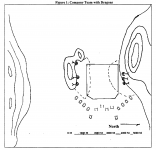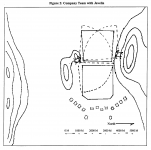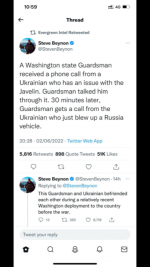A 1997 Monograph on the role of the ATGM in the Bradley Platoon and Combined Arms Team and the impact of changing from the 1973 vintage 1000m SACLOS Dragon with a 20% Probability of Hit and a lower Kill rate to the 2500m (now 5000m) Fire and Forget Javelin with a 90% Probability of Hit and an equivalent kill rate. The target of the day in 1997 was the T72.
JAVELIN: THE NEW CHESS PIECE FOR
THE BRADLEY INFANTRYMAN
A MONOGRAPH
BY
Major Emmett M. Schaill
Infantry
School of Advanced Military Studies
United States Army Command and General Staff
College
Fort Leavenworth, Kansas
First Term AY 97-98
Approved for Public Release Distribution is Unlimited
DTIC QUALITY
The monograph begins with a technical comparison and examination of the
two systems through the use of six critical attributes of manportable, antiarmor
systems. These attributes are lethality, rate of fire, range, gunner survivability
and protection, portability, and ease of training. Next, the monograph examines
the coevolution of armor and antiarmor systems in order to show the importance
of organizational, tactical and doctrinal changes in maximizing the capabilities of
any new weapon.
The monograph then analyzes the use of the Dragon in Bradley infantry units
with the purpose of illustrating how the weapon limits commanders and soldiers
due to its capabilities. Tactical employment of the mechanized company team and
the dismounted infantry element are considered.
Finally, the monograph examines the Javelin and the leap in capability
provided by this system.
what is the role of the man portable ATGM in the dismounted squad tactics of an M2 Bradley unit? Understanding the role of the
ATGM requires an examination of the role of infantry on the battlefield.
According to Colonel John Weeks, author of Men Against Tanks, the infantry
must:
a. Hold ground against enemy armor and infantry attacks and provide a firm
pivot for counterattacks or other maneuvers;
b. Dominate and control the close country;
c. Close with the enemy and clear him from his defensive positions; and,
d. Carry out observation, reconnaissance, and provide early warning.13
General George Patton believed the purpose of the tanks in the infantry divisions
was to get the infantry forward and the purpose of infantry in armored divisions
was to protect the tanks until they could use their weapons on enemy
infantrymen.14
On the mechanized battlefield dismounted infantrymen must be
able to destroy armored vehicles to accomplish their mission.
The platoon is currently organized with four M2 Bradley Fighting vehicles
each armed with 25mm chain gun, TOW missile launcher, and 7.62mm coaxial
machine gun. The gun fires armor piercing ammunition to a maximum effective
range of over 2000m capable of penetrating lightly armored vehicles and high
explosive ammunition for use against infantry and lightly armored vehicles with
effective range of 3000m. The TOW is an anti-armor, wire guided missile with
3750m range and can defeat main battle tanks. The 7.62mm coaxial machine gun
is used for close, unarmored targets and personnel with 900m maximum effective
range. 64
The dismounted element is currently composed of 2 squads of 9 men each,
armed with 6 M249 squad automatic weapons, 6 M203 grenade launchers, Ml6
rifles and 3 Dragons.65 A larger organization, the 2x9+5 was recently tested as
part of the Army Warfighting Experiment. This TOE provides a machine gun
team of five infantrymen for each platoon. This TOE has not yet been instituted
or manned in units.66
The Dragon is employed with the dismounted section as its primary and
longest range portable antiarmor killing system. It is used in conjunction with
AT-4's and other available light antitank systems to destroy enemy armor and
bunkers or point targets.
The Bradley is constrained in bulk capacity also. The vehicle can carry two
TOW missiles in the launcher with a total of 5 missiles stowed in the rear of
either Dragon or TOW. The TOW, being a much more effective weapon of
longer range, would take precedence in load planning unless it could not be used.
The platoon is probably limited to six to eight Dragon missiles unless they cache
for a defense.69
The leader also determines what method he will use to control his element's
AT fires. The two common methods are either centralized under platoon leader
control or decentralized under squad leader control. The distinction becomes
important in controlling volume and timing of AT fires. The unit leader should
also designate priorities of fire by system and rules of engagement in order to
maximize the platoons available antiarmor fires.
So a Bradley Platoon circa 1997 retained 18 dismounts distributed in 24 seats, or 6 seats per Bradley. These were organized into 2 squads of 18 troops carrying 3 Dragon ATGMs.
4 Cars with room for 6 dismounts each, for a total of 24
Carrying 18 troops
Organized on the ground into 2 squads of 9
Operating 3 ATGMs
With the Platoon Leader trying to decide if he stays mounted with his fire power, comms and surveillance system or joins his storm troopers, armed for the close assault, on the ground.
Dismounts as afterthought?
The Bradley was the platoon's dominant weapon and the loss of a seat to 5 TOWs seemed a reasonable trade off.
4 Bradley's with 8 Ready to Fire 3750m TOW ATGMs and 20 Reloads available. 28 ATGMs equals a battalion of T72s.
The 4 25mm Bushmasters would tear up BMPs, BMDs, BTRs, BRDMs, trucks and dismounted infantry between 2000 and 3000 m
The 4 7.62mm Coax would add to the carnage killing dismounts out beyond 900m.
The Bradley fulfills Patton's requirement of the tank as an infantry killing machine with the added benefit of providing overwatch to the MBTs while following in the rear waiting for their opportunity to kill infanteers.
It also had a small contingent of its own infanteers capable of sweeping a suppressed objective and securing PWs. These were armed for the the close quarters battle. Just as the signature weapons of the original Panzer Grenadier were the Schmeisser and the Potato Masher. Not the Kar98 or the MG42.
The problem becomes more apparent when considering the Combined Arms Team
What firepower does the weapon add to a Mech/Tank company team?
The infantry heavy company team will have 10 M2's armed with TOW,
25mm and machine gun and 4 tanks with 120mm main gun, 7.62 coaxial MG and
M2 HB .50 caliber MG. In terms of tank killing capability the team has 20 TOW
missiles uploaded with 5 missiles stowed in each M2 for a total of 70. Assume 12
of these are Dragon missiles and the team has 70-12= 58 TOW missiles. The
Mi's carry a load of 40 rounds per tank or 160 rounds total. The team has 2
platoons of infantry with three Dragon launchers each for a total load of 12
Dragon missiles per company team.73
Assume the TOW and tanks have at least a 90% Pk providing potentially,
(,9)(160+58)= 196 kills. The Dragon Pk of 40% adds (.4)02)= 4.8 or 5, at best,
extra kills of enemy vehicles. In this case does the weapon offer much to the unit
in the way of effectiveness? The potential could be increased by caching more
rounds but the 40% Pk is difficult to surmount. This ideal for number of rounds
and potential is for comparison only. In the fight the initial minutes will probably
be most important as forces attempt to gain fire superiority and the initiative.
From just this basic math the reader may conclude that the Dragon offers
little to the team.

196 TOW and Tank Kills and 5 Dragon kills.
The Dragon was of very limited value and frankly, a waste of space. The ATGM gunner would be better off with a rifle and an AT4 (or a Carl Gustav)
So what happens when the author considers the Javelin?
According to Pfc Joshua Larsen, A Co., 1-5 IN from Force XXI rotation at the National
Training Center "The tanks (OPFOR) are scared of the Javelin". Subsequently,
his platoon killed 4 enemy tanks from their defensive position with no losses.
the increased lethality of the weapon (Javelin) over
the Dragon (91% v 40%) coupled with its 2500m (now 5000m) range offer extensive
improvement in firepower for the infantry. The dual attack modes and tandem
warheads allow destruction of all known armor and engagement of enemy
fortified positions beyond effective machine gun range. Fire and forget launch
increases gunner survivability by allowing immediate reload from a covered or
alternate position.
the Javelin can be fired from inside buildings and fortifications and
has a lower launch signature. The weapon also has equal effect against armor
whether fired from flank or frontally. The flank shot is still preferred but not
essential. These factors coupled with the range and lethality greatly enhance the
options available for effective use and employment of the Javelin and its
contribution to mission success.
Javelin offers greater protection to the soldier and his unit as well. The basic
fact that the weapon can destroy enemy armor at 2500m then be reloaded and
fired within 40 seconds with over 90% Pk is significant protection in itself. The
soldier can move immediately upon firing, and fire from cover with low
signature, again increasing his protection. The Javelin sight allows soldiers to
passively detect targets night or day at up to 3000m further adding to unit
security.
Effectively the Javelin offers a more effective, and dismountable, TOW to the Platoon Commander.
The commander ... can,
with less risk to his soldiers and mission, attack the enemy from numerous
locations where he could not before and need not depend solely on the TOW or
tank for reliable, long range, antiarmor fires. His dismounted infantry forces are
now a potent, and potentially decisive force on the mechanized battlefield.
A ... challenge arises from the command and control difficulties of a
dispersed battlefield. The Javelin allows dispersed squads or teams to integrate
and focus fires to support the plans. Units may not have sufficient
communications equipment to support such distributed operations and must rely
on clear mission oriented orders, well trained small unit leaders and soldiers,
well understood engagement criteria and rehearsal.
The Javelin will be fielded to Bradley infantry battalions at two per platoon (1 per Squad)
or six per company. The M2 still is limited to two TOW missiles loaded with a
combination of five missiles carried in the vehicle, either TOW or Javelin. The
other weapons available to the unit remain essentially the same in the short run
Javelin in the Attack.
The Javelin provides the commander a significant capability in the attack
over the Dragon. The mech team normally has 10 BFV's with 4 tanks and two
infantry platoons. At current planned fielding of two Javelin command launch
units or CLU's per platoon that provides the dismounted infantry 4 launchers and
8 missiles if required. With the greater than 90% Pk the two platoons can plan on
destroying 8 enemy vehicles or positions and more if missiles are available.
In the attack the dismounted infantry can place accurate fire on the objective
from 2500m, and destroying vehicles or critical positions, isolating the objective
area from reinforcement by the enemy and providing all round security for the
unit. These missions all reliably accomplished without the required support of
the units tanks and BFV's. Such a capability can be a significant combat
multiplier when terrain does not support vehicle movement to the objective or
when the defended position cannot be approached mounted without risk.
The Javelin also increases the dismounted element's rationale to infiltrate the
enemy defense. Consider an enemy position that cannot be approached via BFV
or tank without high losses or a critical point that is defended by armor or
fortifications. The units dismounted infantry now have a consistently reliable
weapon with which to reduce a strongpoint and allow armored forces to reach the
objective with support.77
Another possible use is to use Javelin armed dismounted infantry to penetrate
an enemy counter-reconnaissance force. Insertion early should allow the infantry
to provide significant information to friendly forces while remaining protected
from enemy armor. Additionally, this penetration force can reduce the
effectiveness of the enemy force and allow friendly heavy forces to approach the
enemy defense undetected.
The attack now involves more planning for the units leaders. They must now
study terrain to determine where best to place Javelins to integrate them in
support of the units attack or movement. Infantry squads can now secure and
support movement or infiltrations without fully integrated tank/mech support
expanding the capabilities of the force, providing greater security and
necessitating development of tactics and training to support such operations.
Javelin in the Defense.
The Javelin provides the mech team significant improvement over the Dragon
in the defense allowing the commander and other leaders greater flexibility,
lethality and confidence. Using the same example as with the Dragon in the
previous chapter a review of the teams available weapons is helpful.
The infantry heavy team normally consists of 10 BFV's and 4 M1A1 tanks.
The unit will also have 2 dismount elements with a total of 4 Javelin launchers.
Assuming the same ammunition load as for the Dragon example the company has
12 Javelin missiles, 58 TOW missiles, 160 120mm tank rounds and 25mm and
small arms ammunition. Assuming a 90% Pk for tanks and TOWs alone,
disregarding the 25mm and small arms, the unit generates 196 potential kills.
Add in the 12 Javelin missiles at 90% Pk and the unit gains another 10 to 11 kills
equivalent to another enemy company. The enemy force is, at once, presented
with 18 armor killing systems distributed over a large area. The enemy must
disperse his forces to survive while our force can concentrate its effects.
The improvement in firepower is not as simple as this math indicates. The
increased capability rests in the flexibility of the Javelin to be placed in critical
locations through the depth of the defense and to engage enemy armor
simultaneously at long range with the other weapons. It also allows the infantry
forces significant capability in establishing a strongpoint that can provide mutual
support for Bradleys or tanks.
Commanders may also consider increasing their load of Javelins relative to
TOW missiles. To fire the TOW, the Bradley must remain exposed to enemy fire
until impact. The Javelin is a fire and forget weapon that can destroy tanks at
nearly the range of the TOW. This tactic allows the unit to have the 25mm
destroy enemy armored vehicles other than tanks. The combined effect is to
increase fires on enemy formations throughout the engagement area.
The unit leadership must create a defense that integrates all of these weapons
to accomplish the defensive mission. What critical tasks must the unit perform to
optimize its defense and how does the Javelin contribute?
First the commander wants to mass the effects of his units' fires on the enemy
while using terrain and obstacles to disrupt or canalize the formation. This also
allows the enemy to be engaged piecemeal. The defense should allow destruction
of the most dangerous targets first while controlling fires to avoid overkill. The
plan must consider limited visibility conditions, contingencies for enemy actions
or diminished capabilities and emphasize minimal friendly exposure to enemy
fires.78
The antiarmor defense must have both static and mobile elements in order to
be most successful. The static element must be able to stop enemy forces through
destruction, providing obstacles and disruption. The mobile or maneuver element
provides the greatest advantage by locating in some protected location and
moving, when needed, to a position to fire or maneuver, or both, on enemy
armored forces completing their destruction. The Javelin reinforces significantly
the infantry's ability to perform the static mission.79
The Javelin enhances the commander's ability to do each of these tasks with
its range, launch characteristics and lethality. In the initial moments of an attack
a defending unit now has 4 extra tank killers, possibly the critical difference.







